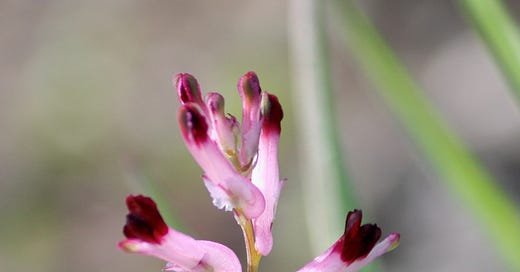My neighborhood has an interesting personality. My family lives in what I consider to be a normal suburban house, albeit a bit larger than average. When we first came to look at this home, we were a bit befuddled by its location. One block north, the neighborhood is mostly majestic 4-5,000 square foot homes. One block south is a small industrial park. One block west is a small collection of run-down and shuttered mom and pop businesses. And for a mile to the east is a collection of interesting and mysterious farmland. My house sits alongside about five normal suburban houses and a few one-bedroom duplexes. It's a very interesting combination which makes for some interesting neighborhood walks.
As you can imagine, most of the houses near mine have finely manicured lawns and flower beds. A few even have perpetually green turf, which in California means they are made of plastic. I have to admit it looks enticing to have such a picture perfect landscape without the water bill. But to be honest, the joy of a leisurely stroll around the neighborhood doesn't really begin until the sidewalk ends.
It’s the weeds I’ve come to see.
I step off the sidewalk and into the road, where I can see the ongoing struggle of nature, determined to take back what is hers. The road puts up a serious fight, but along the ditches, the battle is lost (unless someone from the city arrives with a weedwhacker). When I walk along the road, I am often straddling the overgrowth and the pavement. Veer too much to one side and you risk getting hit by a passing car or trampling the wild undergrowth. It’s really not that serious though. Most drivers give a wide berth and for half the year the weeds are dry and dead.
But recently my meander down the lane (does it count as a hike for the purposes of this blog?) surprised me with fields of cheeseweed, or little mallow, along the roadside. I first saw this flowering plant when I’d moved in a few years ago. It has leaves like a garden geranium but grows very tall. I laughed when my friend told me its name, which it apparently gets from the shape of its fruit. It looks like a wheel of cheese. The year we moved here the cheeseweed was sporadic, but each year since it has become more and more abundant. This afternoon I found a patch that was growing up past my waist.
Across from the cheeseweed is a line of black walnut trees, vestiges from California’s historic orchards, standing firm against the onslaught of Silicon Valley’s “progress” and nature’s ordered entropy. The soil is bare beneath them because the seeds have toxins that prevent things from growing. But the trees are laden with catkins, and for the first time I notice them because my youngest students and I just read about them in their science book. What a precipitous meeting.
Further on I am approaching one of my favorite parts of the walk…an old open-sided woodshed that always seems to be housing a new bird or small wild creature. I once met a beautiful stalk of Milkweed for the first time growing from beneath a broken window along the side of the shed. I stood staring at it in wonder for many minutes those years ago, longing to pick a stem and take it home to the children, but also hoping this wild looking thing would last long enough to spread its seeds and perhaps create more blooms the next year. For the last four years, that beautiful flower bloomed faithfully in the same spot, growing more abundant each time. I wondered if I’d be around long enough to eventually see an entire field of milkweed growing there.
It’s not to be. A local farm bought the land, tore down the shed, and planted a row of cypress trees to delineate and shield its property from the road. A perfect line of trees replacing the decaying shed that had sprouted magical milkweed. Ironically, it’s an industrial-sized flower growing corporation that did the deed. So, somewhere, nearby I assume, some industrial building has a manicured walkway planted with flowers borne at the expense of my dear milkweed.
I turn around and head home, depressed at this new development. Will the walks I take with my children this summer take a new route? How long will I lament the loss of this friend before I find a new one?
I pass the house with the plastic lawn again. I don’t have the same thought about money-saving convenience. Instead, I eagerly look toward his neighbor’s yard. His neighbor has let his yard go. What I imagine was a beautifully landscaped oasis many years ago, now has blackberry brambles growing all over the white picket fence. And in a patch of dirt closest to the road is a bed of flaming pink, where a weed has taken over. I bend over to consider this delicate flower and recognize it as ramping fumitory. Not a name easily forgotten, especially considering its flaming pink hue. My heart lifts a little, and I think I’ll take a walk next week to check on this little weed.
Sarah Jonnalagadda 2023





I live in an older neighborhood where if the yard is green, that's good enough. I have thoroughly enjoyed walking and searching for little flowers. I came across a creeping buttercup that's yellow petals seemed to glisten in the sun. It was magical to watch grow and change. One day on my walk the neighbor had mowed his lawn and the little buttercup was gone! I felt such a sense of loss! Every day since, I've been watching to see if it would come back. The little buttercup showed it's bloom again yesterday! I loved seeing my little friend again.